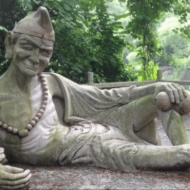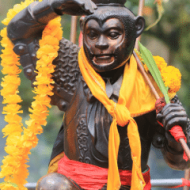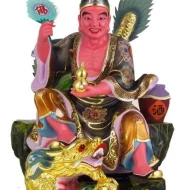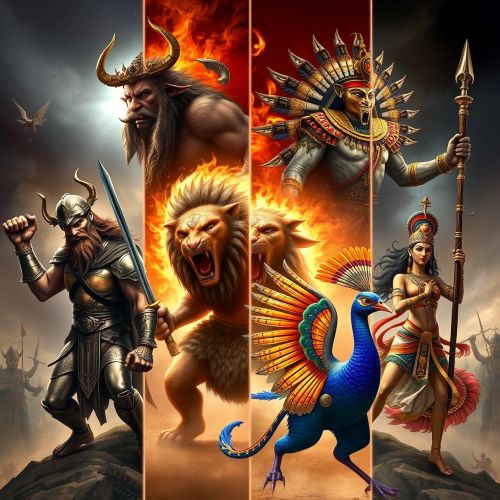Ji Gong : The Drunken Monk
Listen
At a glance
| Description | |
|---|---|
| Origin | Chinese Mythology |
| Classification | Mortals |
| Family Members | Li Maochun (Father) |
| Region | China |
| Associated With | Future Prediction, Martial Arts, Alcohol |
Ji Gong
Introduction
Born in 1130 as Li Xiuyuan, Ji Gong, the Chan Buddhist monk, resided in the Southern Song and asserted possession of supernatural abilities. Leveraging his unique position, he dedicated himself to aiding the impoverished and combating injustice. Ji Gong’s unconventional methods extended to his eccentric and unrestrained behavior, notably defying the dietary restrictions imposed by the Buddhist monastic order on meat and alcohol consumption.
Over time, Ji Gong transcended mortal status to become a revered deity in Chinese culture, securing his legendary status in Buddhist traditions. His presence echoes through a tapestry of folk tales and kans, further cementing his enduring impact on the cultural and spiritual landscape.
Physical Traits
In ragged monastic attire, Ji Gong is frequently spotted sporting a grin while holding a bottle of wine in one hand and a fan in the other. His ensemble is often completed with a hat bearing the character “Fo,” meaning Buddha. Characterized by his easygoing demeanor, Ji Gong is seldom captured with a serious expression.
Family
In the year 1130, Ji Gong, originally named Li Xiuyuan, was born according to Chinese historians. Hailing from Zhejiang Province, he grew up in the care of his military advisor father until tragedy struck at the age of 18, leaving him orphaned. Despite inheriting wealth and status, Li Xiuyuan chose a contemplative life in a monastery rather than embracing his familial privileges.
Upon adopting the name Daoji, his transition to life in Lingyin Temple proved challenging. Struggling with the stringent rules imposed by the monks, Daoji, formerly Li Xiuyuan, faced difficulty conforming to the disciplined environment. Initially a struggling student under a highly esteemed teacher, he openly defied monastery regulations by indulging in wine, consuming meat, and speaking out of turn. Despite these actions, Daoji remained deeply rooted in Buddha’s teachings.
Legends surrounding Daoji’s departure from the monastery vary. Some assert that he left voluntarily, unable to adhere to the strict rules, while others claim he was expelled due to his unconventional behavior.
Other names
Ji Gong was born as Li Xiuyuan and was later given the name Daoji. He has also been referred to as the Mad Monk and the Drunken Monk.
Powers and Abilities
In a legendary tale, the construction of a temple in Hangzhou faced a challenge – the monks required timber, and the finest wood could only be sourced from Sichuan province. Despite the dire circumstances, Ji Gong, with his supernatural abilities, effortlessly transported logs to Hangzhou. As the monks began tallying the logs, Ji Gong halted one mid-air when the count commenced. The remaining log, untouched, found its place in what would later be revered as the Divine Teleportation Well.
Another fable recounts Ji Gong’s foresight, foreseeing a mountain peak perilously heading towards a nearby village. Despite his warning, the villagers dismissed his cautionary words. Determined to avert disaster, Ji Gong took drastic action. Spotting a wedding procession in the village, he seized the bride and carried her over his shoulder. The commotion alerted the wedding guests, and they, in turn, summoned friends and relatives to pursue the abductor. Miraculously, a massive mountain peak crashed into the village just as people cleared the gate, sparing the community from impending disaster.
Modern Day Influence
Ji Gong has been portrayed by numerous actors in films and television series from as early as 1939 but received international acclaim after Stephen Chow’s 1993 film, The Mad Monk.
Related Images
Frequently Asked Questions
What is lorem Ipsum?
I am text block. Click edit button to change this text. Lorem ipsum dolor sit amet, consectetur adipiscing elit. Ut elit tellus, luctus nec ullamcorper mattis, pulvinar dapibus leo.
What is lorem Ipsum?
I am text block. Click edit button to change this text. Lorem ipsum dolor sit amet, consectetur adipiscing elit. Ut elit tellus, luctus nec ullamcorper mattis, pulvinar dapibus leo.
What is lorem Ipsum?
I am text block. Click edit button to change this text. Lorem ipsum dolor sit amet, consectetur adipiscing elit. Ut elit tellus, luctus nec ullamcorper mattis, pulvinar dapibus leo.
What is lorem Ipsum?
I am text block. Click edit button to change this text. Lorem ipsum dolor sit amet, consectetur adipiscing elit. Ut elit tellus, luctus nec ullamcorper mattis, pulvinar dapibus leo.
What is lorem Ipsum?
I am text block. Click edit button to change this text. Lorem ipsum dolor sit amet, consectetur adipiscing elit. Ut elit tellus, luctus nec ullamcorper mattis, pulvinar dapibus leo.







